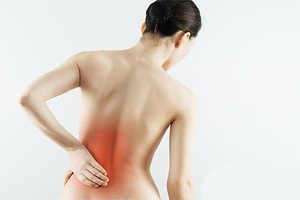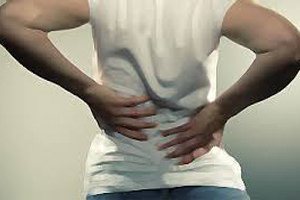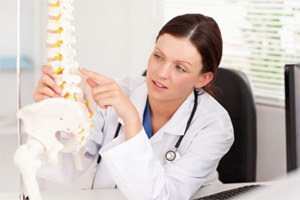Among them, – lumbago, sciatica, degenerative disc disease and other pathological changes in the lumbar-sacral spine. It's not worth it to treat it carelessly, because the pain in the lower back and it not only can achieve the incredible power that a person's life unbearable, but also be a symptom of a dangerous disease.
Pain in the lower back can be diverse: acute or dull, aching or burning, local (to show in one place), or that the entire back. Manifest uncomfortable feelings, too, in different ways: sometimes sharply, suddenly, sometimes gradually, is growing every day.

Response to pain and ability to tolerate her depends on many factors: age, psychological characteristics, accompanying symptoms and other. But in any case can not throw the disease course. Timely begun treatment can help you avoid dangerous effects.
To diagnose the cause of back pain, is needed examination of the spine and some other procedures: imaging, computed or magnetic resonance imaging.
Bouts of pain in the lumbar-sacral department are manifested in the course of life in about 80% of the current population of the european countries. Acute or chronic lower-back pain – a consequence of a variety of neurological, degenerative-dystrophic disease in women and men. In some cases, pain in the lower back – the result of diseases of internal organs, obesity, stress and mental disorders.
Causes of pain in the lower back
The problem of chronic lower back pain lasts on the order of the day. The average age of the sick is falling fast, currently it amounts to 35-45 years. There are even recorded cases of the disease in children and adolescents.
Prerequisite for the development of pain syndrome lower back pain – a sedentary way of life of modern man, which leads to a reduction in the resilience of the backrest itself vulnerable departments of the skeleton. Pain in the lower back pain visit many diseases that have become a common cause of treatment to a neurologist, urologist, surgeon, gastroenterologist and a gynecologist. It is assumed a further deterioration of the problem. The following generation is different healthy way of life.
Pain in the lower back pain in women
Arise in the period of gynecological diseases, or are the result of characteristics of the female physiology:
- Gynecological disease. Inflammation of the appendages – adnexitis, is accompanied by pain in the lower abdomen, sometimes the pain radiating to the lower back (the pain of one - and two-sided), also manifests the symptoms from the intimate sphere (the inability to conceive after a long period of time blurring the discharge before and after menstruation, the pain is amplified during sexual intercourse);
- Pregnancy;
- Climax;
- Pain – result of increased suspiciousness, more frequently occurs in women. In-depth, comprehensive examination may not reveal the pathology. The problem can occur occasionally or consistently. Treated by psychological correction. These pains may occur without the influence of menopause.
Back pain in men
Recurrent pain arise in connection with the functions of the professional activities of men, including, if the pain is:
- do not correspond to the physiological status of the body of a man;
- it is associated with professional risk (work in cold, draughty).
Pain in the lower back and in men and in women
Arise in connection with the acute diseases of the gastrointestinal tract, surgical complications, kidney diseases, metabolic disorders, diseases of an infectious nature, and tumors (benign, malignant).
- Appendicitis. Characteristic pain localized in the right iliac region, can sometimes irradiate in the lower back, more often on the right side of the body. Occurs an unexpected pain in the area lumbar.
- Pathology of the small separation of the colon. Are accompanied by symptoms characteristic of disorders of the gastrointestinal tract. The pain radiates in the lower back due to irritation of the fibres of lumbar nerves.
- Cholecystitis. Pain resemble the symptoms of appendicitis. Usually localized on the right side in the iliac region or in the region of the navel. Sometimes they give in the lower part of the back when drawing in the pathological fibers of the spinal nerves.
- Pancreatitis. Typical encircling pain throughout the body, in the waist area, manifested in the lumbar department. In combination with its characteristic symptoms of pancreatitis – vomiting, a violation of stool, primers on the language. In the case that the cause of the pain – pancreatitis, the area of the spinal pillar in the sense of not reacting in response to application of force.
- Adhesions after surgery. Arise after laparotomy or cavitary operations on the organs of the abdominal cavity, sometimes to diagnose the congenital adhesions. Pain localized in different parts of the abdominal walls, radiates in the lower back.
- Diseases of the kidney. Pain in the lower back combined with pain, headache, increase in diastolic (lower) threshold of blood pressure, edema. The characteristic changes are in the laboratory studies, urine tests, instrumental studies, renal – ULTRASOUND, MRI;
- Obesity fourth degree. This is an extreme degree of increase in fat mass in humans. Body mass index the fourth degree (under 25 years) = 40, the second group (25) = 41. Its define as the ratio of weight (kg) at twice the initial growth rate (m). Causes the load on the lower back clear without explanation.
- Infection points, involving in the pathological bone tissue, for example, extrapulmonary (bone), the tuberculosis. Manifested with pains in the bones. Localization of pain in the lower back is associated with the fact that this is a massive separation of the vertebrae pillar, and it is susceptible to the maximum stress. The symptoms associated with the clinic of a chronic infection. They reveal a slight hyperthermia, fatigue, headache, symptoms of lesions of the nervous system, laboratory reveal tuberculosis wand.
- Myositis – inflammation of muscles. The muscles of the lumbar zone bear a greater burden, so the inflammation of the lumbar zone occur frequently. The disease develops as a result of hypothermia, the penetration of pathogens of viral (herpes Zoster), bacterial infections (Staphylococci, streptococci, other bacteria) tissue in this area. Is manifested by increased body temperature, severe pain related suddenly, after a local or general hypothermia. Chronic phase of the disease is manifested by aching pain, sometimes with the points involving the tissue of the skin and subcutaneous tissue disorders (dermatomyositis). The diagnosis made on the basis of the clinical survey of the patient, examination, palpation and laboratory techniques.
- Overgrowth of benign and malignant tumors in the course of the nerve fibers, Innervate the lower back. The symptoms are diverse, match the stage of the disease and the localization of the pathology.
Persistent and recurrent pain in the lower back

There are different classifications of pain, including, depending on the length.
- Recurrent pain is usually associated with physical exertion, physiological functions of the human body or acute diseases of the internal organs.
- Permanent, sharp, chronic pain, caused by irreversible pathological processes in the body in diseases of the musculoskeletal system the human skeleton and lesions in the deep vessels of the lower extremities.
Recurrent pain in the lower back - so they are called because they disappear after a recovery and solution to the hearth of the pain.
The origin of such pain may vary in women or men, either in the same degree apply to men and women.
Constant pain in the lower back is often caused by inflammatory signalling and irreversible dystrophic and degenerative neural processes in bone and cartilage, severe disorders of blood circulation of blood vessels of the legs. Constant pain in lesser extent associated with damage to the muscles and internal organs.
The pain is called a constant, if is the removal of the fireplace momentum difficult, due to the development of irreversible processes in bone and cartilage. Degenerative and dystrophic processes are usually non-refundable a complete cure. You can pause or stop the time. In some cases, the pain is removed after the replacement of damaged tissues on the implant.
Regular and continual pain often have close ties between each other, so the temporary pain becomes constant.
For example, bone, tuberculosis causes a violation of the nutrition of the cartilage, osteochondrosis provokes, and pain is manifested by almost constant, with periods of weakening and deterioration.
Curvature of the spine (scoliosis) - at first takes place subtly, manifested regularly, further passes in osteochondrosis, and is manifested by constant pain. Examples can be continued.
Disease, accompanied by persistent pain in the lower back:
- Lumbago – acute pain in the lower back. A consequence of pathological changes in the lumbar vertebrae. In the initial stages, the pain may stop, so as the disease process when quick treatment is eliminated. Develops suddenly, while lifting weights and other similar causes. More frequently diagnosed in men. Lumbago – the best in the wake of several diseases, such as, for example, displacement, herniated disc, pinch the points of the roots of the nerves in the lumbar (neuralgia), inflammation or pinch points of the sciatic nerve – degenerative disc disease, and other anomalies of the vertebrae. In addition to severe acute pain, is manifested by a reduced ability of movement and orientation of the skeleton in the area of the lower back. In the absence of treatment or incorrect treatment of lumbago may turn into a permanent disease of the bone tissue.
- Intervertebral osteochondrosis – includes several diseases of inflammatory and dystrophic character, manifested initially destruction of the articular surface of the cartilage and bone tissue involvement in the pathological nerve.
- Scoliosis. The curvature of the vertebrae to the sides, is manifested asymmetry of the shoulder line, broken posture, deformation of the skeleton, the education of the costal hump, which is visible in the slopes. Develops when the lower functions of the bones of the skeleton and muscles, the dystrophic processes in the cartilage ridges. Manifested as bone pain skeleton in heavy cases. Long scoliosis is asymptomatic. Scoliosis is often congenital and acquired.
- Ankylosing spondylitis – a loss of joint mobility. Significantly more frequent in men. Another name pathology – the disease ankylosing Spondylitis. Is chronic inflammation. The disease is manifested by pains in the joints and the spine, is characterized by the disability of the eyes, a decrease in the growth of the person. When this case happens the overgrowth of the connective tissue of the joints and spine.
- Spondylosis. It is the process of natural aging of the joints. There is a gradual thinning and loss of mobility of the lumbar joints. Pathologic takes place in a complication of and accession to the inflammation of the current spondylosis. Symptoms are consistent with inflammation of the joints of the spine.
- The leg length discrepancy of more than 2-3 cm, is accompanied by different pains in the motion, including pain in the lower back. Pathology develops, as is atrophy of the muscles of one leg due to suffering childhood polio and other diseases. In some cases, to deal with the issue using the orthopedic cards. The defect is difficult to determine when too large a difference in leg length or low-rise feet.
- Osteoporosis – thinning, is the leaching of calcium from the bones. Often causes fractures of the femoral neck. Watching the of lumbar osteoporosis. Manifested by the deformation of the skeleton, joints, cartilage, development of a hernia vertebral. More often women become ill in the period of menopause.
- Thrombophlebitis – partial or complete cessation of blood flow through deep blood vessels. In combination with inflammation around the vessel. It complicates the course of the disease provokes the development of pain syndrome even at rest.
To what doctors to go to?

With pain in the region of the spine in the first place it is necessary to treat only neurologist in a district clinic, if the patient's condition stable, or an ambulance. Pain in the lower back can be one of the symptoms of gynecological, urological, surgical and gastroenterological problems.
Pain in the lower back is often combined with various infections and injuries of the extremities. It is not excluded pain syndrome lower back pain in diseases of the heart and lungs. It is set in the in-depth examination.
After the patient will put a diagnosis, he's usually prescribe drugs that pain in the lower back pain, normalizes blood circulation and help to restore the nervous tissue. It can be tablets, gels, ointments or injections, the removal of the inflammation and spasms.
Surgical intervention is usually necessary when the diagnosis of a herniated disc, which is a complication of degenerative disc disease. A hernia that pushes on the nerve the spine, removes the recovering, and the pain will fade.
Preferably the spine and muscles to relax, if he sleeps on the hard mattress, the fact that under the knees small pillow. While bed rest may not last too long, because it can result in weakening of the muscles, that will only exacerbate the problem. Even in the strong headaches it is necessary to try to keep at least a little physical activity.

























